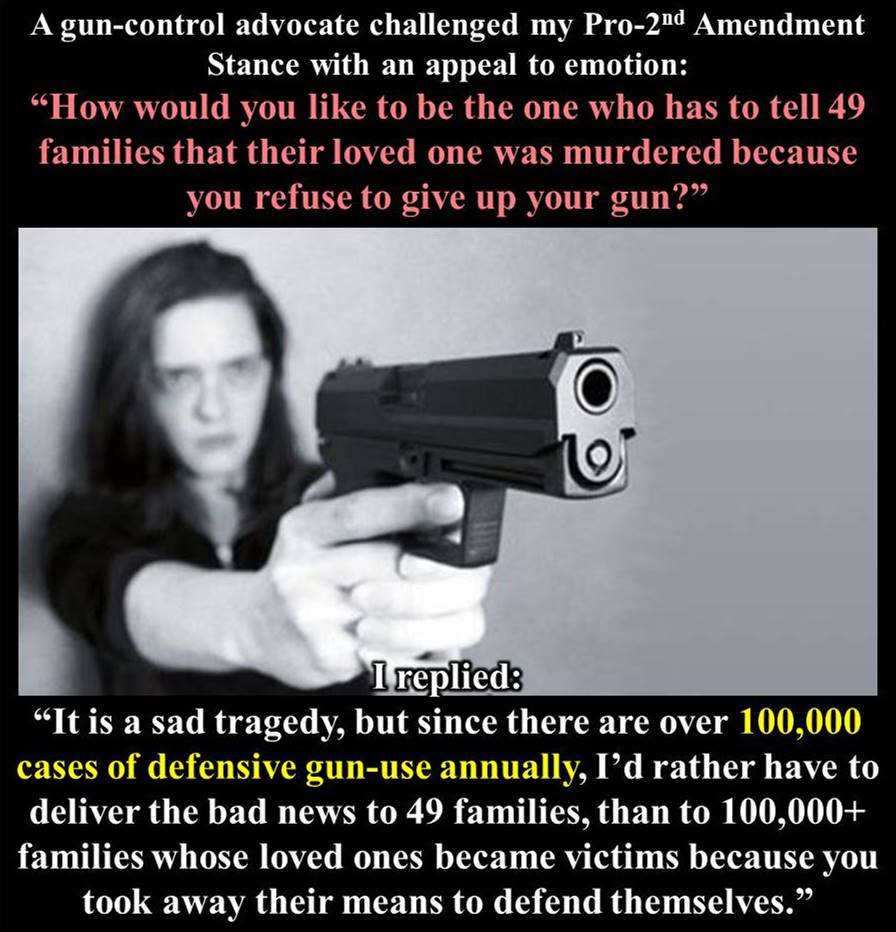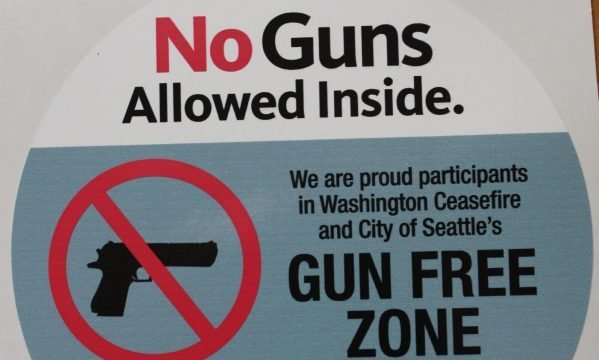WHY AMERICA NEEDS GUNS: Another Mass Shooting, Another Gun Grab Discussion

Every time there is a mass shooting, the topic of gun control comes up.
Arguments for gun control ranges from the hard-liberal stance of "only the government (and my bodyguards) may have guns," to the more well-intentioned "But we must do SOMETHING to prevent something like this from happening."
For now, let's ignore the Constitutional Rights argument, or the "need it to defend against tyranny" argument.
Let's look at it from a purely pragmatic, "How do guns affect our lives" approach.
There is a slew of conflicting statistics thrown around by both gun-grabbers and gun-rights activists. Thus for this article, we will be focusing primarily on facts presented in "Priorities for Research to Reduce the Threat of Firearm-Related Violence," a 2013 comprehensive study by the National Academy of Sciences, sponsored by the Centers for Disease Control and Prevention (among others), and commissioned via Executive Order by former US President Obama "directing federal agencies to improve knowledge of the causes of firearm violence, the interventions that might prevent it, and strategies to minimize its public health burden."
Note: Despite the "appeal to authority" fallacy, I feel that this is perhaps the most unbiased source publicly available, short of hacking into the FBI database, which is frowned upon.
So the question is, "Are we better off with guns or without?"
Looking at the facts:
"According to the FBI’s Uniform Crime Report, 46,313 people were murdered in incidents involving firearms between 2007 and 2011 (FBI, 2011b)."[1]
That comes to over 9000 murders a year.
How does that compare to murders with other weapons?
"During that same time, firearms accounted for more than twice as many murders as all other weapons combined (FBI, 2011b)."[1]
Thus over 2/3 of all murders were committed by guns, which would indicate that private ownership of guns has a negative impact on the population.
But on the flip side, what about the factor of "good guy with a gun?"
"Defensive use of guns by crime victims is a common occurrence, although the exact number remains disputed (Cook and Ludwig, 1996; Kleck, 2001a). Almost all national survey estimates indicate that defensive gun uses by victims are at least as common as offensive uses by criminals, with estimates of annual uses ranging from about 500,000 to more than 3 million (Kleck, 2001a), in the context of about 300,000 violent crimes involving firearms in 2008 (BJS, 2010). On the other hand, some scholars point to a radically lower estimate of only 108,000 annual defensive uses based on the National Crime Victimization Survey (Cook et al., 1997). The variation in these numbers remains a controversy in the field. The estimate of 3 million defensive uses per year is based on an extrapolation from a small number of responses taken from more than 19 national surveys. The former estimate of 108,000 is difficult to interpret because respondents were not asked specifically about defensive gun use."[1]
As you can see, the actual number of cases of defensive gun use is very hard to pinpoint, due to variability in reporting, interpretation, and definition of what "defensive gun use" entails. For example, we cannot accurately predict the deterrent factor, since we don't know how many crimes are prevented due to the POTENTIAL perpetrator being deterred by fear of the potential victim being armed.
Anecdotal example: I've personally witnessed a random confrontation be defused by the presence of a gun. Two men were crossing a busy NYC street from opposite directions. Neither yielded, and bumped shoulders as they passed each other. Both turned and exchanged words. First guy pulled out a knife. Second guy opened his jacket to reveal a gun in his waistband. First guy walked away. Incident defused, but will never show up in any statistic.
But how effective is the "good-guy-with-a-gun" factor?
In 2012, across the nation there were only 259 justifiable homicides involving a private citizen using a firearm reported to the FBI Uniform Crime Reporting (UCR) Program as detailed in its Supplementary Homicide Report (SHR). That same year, there were 8,342 criminal gun homicides tallied in the SHR... For the five-year period 2008 through 2012, there were only 1,108 justifiable homicides involving a gun."[2]
So for every bad guy killed by a potential victim, there are 32 murdered victims. This kill-ratio seems dismal, but remember that the primary objective of a good-guy-with-a-gun isn't to kill the bad guy, but to stop the bad guy from doing bad things (using lethal force if necessary). So it's actually a GOOD sign for humanity that out of the 100,000+ defensive gun use per year, only a few hundred cases result in death.
Thus even without killing the bad guy, being armed plays a big part protecting victims:
"Studies that directly assessed the effect of actual defensive uses of guns (i.e., incidents in which a gun was “used” by the crime victim in the sense of attacking or threatening an offender) have found consistently lower injury rates among gun-using crime victims compared with victims who used other self-protective strategies."[1]
Unfortunately it's hard to quantify exactly how effective it is, because it's a matter of "what ifs." A potential rape victim who shoots her attacker may still sustain injuries in the confrontation, but the injuries would presumably be lesser than getting raped in addition to getting shot or stabbed.
On the other hand, criminals can also commit crimes aided by guns without killing, and actually most illegal gun use does NOT involve someone getting killed:
"Approximately 3 percent of firearm-related assaults known to the police (which represent a portion of total firearm-related assaults) are fatal (computed from FBI, 2011c)" [1]
"Guns also can be used to intimidate and coerce through threats of violence. In 2010, firearms were involved in less than 6 percent of the total 3,148,250 reported aggravated or simple assaults (Truman, 2011). Similarly, less than 7 percent of all rapes or sexual assaults in 2010 involved a firearm (Truman, 2011)."
Read that again: Less than 7% of assailants or rapists had used a gun to impose their will on the victim. That means the vast majority of violent crimes were committed with weapons other than guns.
Therefore, even if nobody had guns, both good guys and bad guys, criminals would still be committing violent crimes, just with an alternative weapon. There's no data on what-ifs (unless we develop Minority Report technology), but logically I would surmise that the number of criminals deterred by not being armed would be fewer than the number of criminals emboldened by the prospect that none of their potential victims would be armed. As if criminals followed the law anyway!

I would rather have to deliver the bad news to the 49 families of those massacred in Orlando, or the 10,000 families of those murdered by guns every year, than to have to tell 100,000+ families that their loved ones were not able to defend themselves because we took their guns away, in ADDITION to the 10,000 and 49.
[1] http://www.nap.edu/download/18319
[2] http://www.vpc.org/studies/justifiable15.pdf
Adapted from a meme found on WE ARE CAPITALISTs page.

libertyLOL's "Divide and Rule"
If you enjoyed, Please Upvote, Follow and Resteem!
Follow libertyLOL on your favorite sites:
Steemit blog
Facebook
Twitter
Reddit
Youtube
Tumblr
Instagram
Pintrest
Countable: Government Made Simple
Patreon
Gab.ai
libertyLOL's Liberty Blog RSS Feed
We also run a couple twitterbots which provide great quotes and book suggestions:
Murray Rothbard Suggests
Tom Woods Suggests
Jason Stapleton Suggests
Progressive Contradictions

Nicely articulated piece. It is so hard to quantify deterrence value since, by nature, if it exists, then the crime doesn't occur and doesn't get recorded. So the deterrence value of an establishment being tagged as a hang out of police officers, NRA members, soldiers... would mean that these businesses would expect lower crime rates than similar businesses with "Gun Free Zone" signs. Criminals are looking for easy gain of something, property, control, etc... and it would be illogical to think that they would intentionally select more challenging targets, such as those that are presumably are well defended, but would rather give their attention to softer targets.